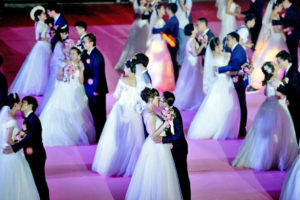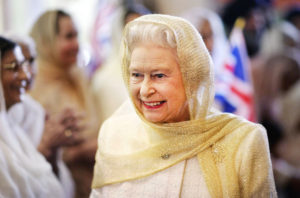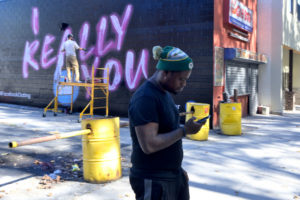Marriages are supposed to be made in heaven — not in dilapidated local authority registry offices. My wife and I were getting a civil marriage, as our Islamic wedding the previous year, for all its ceremonial pomp, had been a statutory nullity. Others elope from their families; we’d eloped from the law. It was out of laziness at first, then — maybe — something else. We were on board with a spiritual union in fulfilment of a romantic aspiration, but did this sentiment really need to be ratified by the state? “Marriage is an institution,” Groucho Marx once quipped. “But who wants to live in an institution?”
What the modern sensibility reveres is the marriage of hearts and minds — not of legal entities, or strands in the social fabric. Being admitted to this institution, via its bureaucratic rituals — interrogation by a council official, signing a register, publicly exchanging vows with a wording enshrined, to my surprise, in statute — reminded me of the civic nature of marriage. Deciding to get married, and whom to marry, is in addition to being a personal choice, a political one. It involves much larger questions than simply the conundrum of desire: questions about community, and where we slot into the society around us.
With this sudden realisation, I wondered what it meant that every couple waiting at the registry office was of the same race. All appeared to have “married in”. I should not have been surprised. In multicultural Britain, most marriages are still between members of the same ethnicity. Only 10% of households comprise an “inter-ethnic cohabiting couple”, to use the ONS vernacular. Perhaps, for the white majority, it’s simply the likeliest outcome to fall for someone of the same race (only 4% of white people do otherwise). But ethnic minorities marrying primarily among their own, rather than into the generality, is quite against the odds. Yet that is what transpires. British-Asians — of whom 90% marry in — are the most exclusive, compared with 60% of black Britons. Among all minority groups, though, something greater than the free play of attraction seems to be at work in the choice of a life partner.
I’m a British-Asian; so is my wife. Our marriage wasn’t arranged, and is thus what Indian-English calls, often with a hint of scandal, a “love marriage”. We’re both journalists, and since the society around us is our subject-matter and our audience, we’ve had to be pretty well-integrated into it. We are not entirely secular, since we do practise a religion — not a popular one these days — but in a fashion our peers would approve as “moderate”. Our marriage followed Western norms of individual choice more than South Asian norms of parental orchestration. Nevertheless, we have done as most ethnic minorities do: we married in.
Why does this matter? “Ethno‐religious intermarriage is regarded as the most complete form of social integration,” the demographer David Voas has said. “Its frequency is therefore of public interest.” If marriage is an institution, it’s apparently a segregated one, which surely offends Left and Right equally. That liberals trumpet diversity while conservatives favour assimilation normally results in disagreement, but on this issue, their values lead to the same conclusion; ethnic in-marriage is a failure of diversity and of assimilation.
For a long time, popular culture has therefore been unanimous in promoting a vision of all ethnicities coming together through intermarriage in society’s great melting pot. That phrase itself we get from a play by the Anglo-Jewish writer Israel Zangwill. The Melting Pot — from 1908 — sees a Jewish refugee from Russia, David, falling in love with a Christian woman, Vera. He writes a symphony celebrating the melting away of distinctions between “East and West, and North and South, the palm and the pine, the pole and the equator, the crescent and the cross.” Vera is so moved that she marries David.
Much of what I watched, while growing up, told the same story: classic movies like West Side Story and Pocahontas, Hollywood franchises like My Big Fat Greek Wedding, the breakout films of the South Asian diaspora, Mississippi Masala and Bride and Prejudice. All insist that the model minority integrates through marriage. The cultural signals were often more subtle. By the time I got to university, for instance, the message was underscored in the notion of “hybridity” — then all the rage in literary theory — which saw culture itself as the fruit of crossbreeding. Our future was hybrid, we were told, and race, like gender, was a boundary to be transgressed.
So I did my part. My relationships exemplified the liberal ideals of multiculturalism and mobility. There were romances in various corners of Europe. During that high-water mark of Britain’s membership of the EU, so many of my generation pursued ever closer union, quite intimately. And for most Westerners, integration in relationships continues to hint at a grander political project. Hence the outrage over the government’s salary threshold for spousal visas, prompting one commentator to declare: “Western liberalism was built on the principle of marrying out.”
It was during the Enlightenment that the West began to adopt the ideal of marrying out, alongside other beliefs about the individual’s freedom from communal constraints. By the 19th century, as exotic women caught the eyes of imperial adventurers, Western intellectuals were promoting intermarriage as a form of progress, something the more benighted races were incapable of. “Savage nations,” Alexander von Humboldt wrote, “form no intermarriages”.
Anthropologists actually tell us the opposite. What they call exogamy — marriage outside the group — originated in primitive societies where wives were practically slaves. It was therefore treacherous to inflict marriage on one’s own; brides were captured from elsewhere. Once civilisations accorded women a higher status, they tended towards endogamy — marriage within the group. A woman’s right to inherit property, for instance, provided an incentive to keep her wealth within the clan and dignified her with a lucrative hand to be vied for.
Consider the world of Jane Austen. Her quintessentially English novels document the workings of a basically South Asian-style endogamy. The landed gentry scheme to find suitable claimants to their daughter’s dowries while their daughters scheme to find companionship. Literary critics call it the marriage plot. This, in the critic Tony Tanner’s famous definition, is how “society attempts to bring into harmonious alignment patterns of passion and patterns of property”. The marriage plot isn’t fiction: it described the norms of the elite, an in-marrying cadre of Cecils, Churchills, Darwins, Huxleys, Macaulays, Thackerays: the great scions of Britain’s classic liberal age, which was built, in fact, on the principle of marrying in.
Outraged by such rampant endogamy, George Bernard Shaw argued that one of the goals of politics should be “to keep the entire community intermarriageable”. Intermarriage was being posited then as a remedy to class division, much as it would later be promoted to prevent ethnic ghettoisation. But Shaw himself married within the Anglo-Irish intelligentsia, just as Israel Zangwill, even as he was writing The Melting Pot, couldn’t help but marry a fellow Jew. Those who preach inclusive political ideals have often been the most scrupulous in-breeders. For a while my MP was an exemplary socialist whose father and mother were both Labour MPs. He also married a Labour MP, herself the sister of yet another Labour MP.
Intermarriage is an ideal everyone professes but few practise. Of course, not living up to an ideal is no reason to discard it. But many other cultures, including those foundational to the West, do seem to have had a more realistic view of human behaviour. The citizens of Athens, the first democracy, could not marry non-citizens, much as Romans would not marry so-called barbarians. Such laws have, fortunately, been abolished. Today, they would be indefensible. But our habits haven’t changed all that much in the intervening millennia, even if our ideals have.
In my newly married life, I have been wondering what, after a youth of romantic hybridity, changed for me. In The Right to Sex, the Oxford philosopher Amia Srinivasan argues that attraction isn’t what we think it is, something ultimately private and “pre-political”. Instead, our deepest desires are conditioned by politics and — this is her aim — subject to critique. By my mid-twenties, it was only to women of my own ethnicity that I was drawn. This shift, on reflection, appears to me political, or at least politicised.
If my interethnic relationships took place in an era of intercultural optimism — of free movement, free trade, open borders — my yearning to be with a woman of my own “kind” coincided with the counterrevolution against that world. In Eden, before tasting the bitter fruit that exposed their otherness, Adam and Eve loved freely; the explosion of identity politics across the West marked the end of another innocence — our innocence about distinctions of race. From Black Lives Matter to Trump’s “Muslim ban”, the rhetoric of interracial suspicion permeated the entire Anglosphere. As politics became more identitarian, so did my romantic inclination.
In a framing that has caught on since the West’s post-liberal turn, people are supposed to be Somewheres or Anywheres. The Somewhere is rooted in a close-knit community, sceptical about change, about outsiders, while the Anywhere is cosmopolitan, embraces change, celebrates the other. Recent years have seen the Somewheres in revolt. And my marriage, I now realise, was in league with that revolt against the precarity and flux of Anywhere. In an uncertain world, I retreated to the safety of Somewhere, moving with my wife back to East London, where we can without embarrassment dine nightly on curry and rice.
Marriages, intrinsically, involve a vision of being rooted somewhere. The “Anywhere” catchwords — freedom, mobility, change — all run counter to it. That’s why the greatest liberal philosopher, J.S. Mill, equated marriage with slavery: it was an insult to human autonomy. (He still wed.) This contradiction, between an institution based on constraint and a culture that valorises freedom foremost, is keenly felt today. For the first time in history, fewer than half of adults in the UK are married. The impetus of the Enlightenment that first promoted intermarriage as an ideal has since led to all sorts of alternative relationship patterns, in which many have found fulfilment. But for ethnic minorities wishing to stick to matrimony, to marry into familiar territory is to follow the unavoidable logic of the institution itself.
If marriage within ethnic limitations reflects the “Somewhere” ethos, the “Anywhere” ethos can be encapsulated in dating apps, with their unlimited romantic possibilities, wherever you may be in the world. At first this seemed ideal for my generation. But several years down the line, the same people often long for some kind of alternative. Popular culture is becoming more and more fascinated by ethnic minorities who spurn the apps in favour of something a bit more traditional. Many a Netflix-viewing Anywhere has been addictively streaming the hit show Indian Matchmaking (and the spinoff, Jewish Matchmaking). In the recent Rom-com What’s Love Got to Do with It?, a white woman finds herself fascinated by her neighbour’s arranged marriage to a fellow Pakistani. It was written by Jemima Goldsmith, formerly Khan, who knows well the challenges of a mixed marriage.
In my own “Anywhere” days, I was only dimly aware of such challenges. There was an unease I felt that I could not properly account for. I recall once awakening from a dream about my future children, in which I could not speak to them in my mother tongue, the only language of familial intimacy I know. There was also the occasional nuisance of cooking two differently spiced meals over dinner. If no diplomatic solution could be found for a conflict over seasoning, what hope was there for much more vexed religious and cultural disagreements, between, as Zangwill put it, “the Crescent and the Cross”? Only now do I realise that there was always a kind of political unrest brewing within otherwise romantically compatible relationships.
Marriage is political, and choosing whether to marry in or out has been like choosing between citizenships. But there are no citizens of the world in marriage; whenever you choose someone, I feel, you are also committing to Somewhere. For those of us who have been shipwrecked on these shores by the odyssey of migration, the need to feel at home is all the more acute. A marriage must feel like home. After all, what is the home, the nostos, that Odysseus ventures to return to?
It isn’t a state, nor even really a place; it is a marriage. And if I can put it in a word, with my wife, I feel at home.
Disclaimer
Some of the posts we share are controversial and we do not necessarily agree with them in the whole extend. Sometimes we agree with the content or part of it but we do not agree with the narration or language. Nevertheless we find them somehow interesting, valuable and/or informative or we share them, because we strongly believe in freedom of speech, free press and journalism. We strongly encourage you to have a critical approach to all the content, do your own research and analysis to build your own opinion.
We would be glad to have your feedback.
Source: UnHerd Read the original article here: https://unherd.com/





